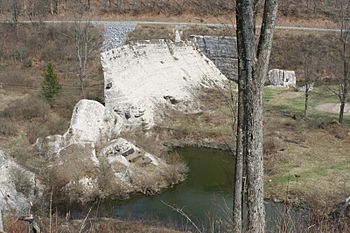Austin Dam failure (Pennsylvania) facts for kids
Quick facts for kids Austin Dam |
|
|---|---|

Remnants of Austin Dam in 2008
|
|
| Location | Keating Township, Potter County, near Austin, Pennsylvania |
| Opening date | December 1909 |
| Demolition date | September 30, 1911 |
| Operator(s) | Bayless Pulp & Paper Company |
| Dam and spillways | |
| Impounds | Freeman Run |
| Height | 50 feet (15 m) |
| Length | 540 feet (160 m) |
| Reservoir | |
| Creates | Austin Dam Pool |
| Total capacity | 200,000,000 US gallons (760,000,000 L) |
|
Austin Dam
|
|

School house after dam disaster
|
|
| Location | PA 872, Austin, Pennsylvania |
| Area | 1.3 acres (0.53 ha) |
| Built | 1911 |
| Built by | Hatton, T. Chalkey |
| NRHP reference No. | 86003570 |
| Added to NRHP | January 15, 1987 |
The Austin Dam, also called the Bayless Dam, was a huge concrete dam in Austin, Pennsylvania. It was built in 1909 to help the Bayless Pulp and Paper Mill get enough water. At the time, it was the biggest dam of its kind in Pennsylvania. Sadly, the dam broke completely on September 30, 1911. This caused a lot of damage and many people lost their lives in the valley below.
Contents
History of the Austin Dam
Building the Dam
In 1900, George Bayless started a paper mill in the Freeman Run Valley. By 1909, the mill needed a more steady water supply. This was because dry seasons sometimes meant not enough water. After a small dirt dam didn't work, a company called T. Chalkey Hatton was hired. Their job was to build a large concrete gravity dam across the valley.
The dam was 50 feet (15 m) high and 540 feet (160 m) long. It cost $86,000 to build. It was planned to be thirty feet thick. However, it was built only twenty feet thick. Also, a special underground concrete wall was supposed to stop water from leaking under the dam. But this wall was not built because Mr. Bayless thought it was too expensive. Back then, Pennsylvania had no rules for building dams.
People in the town of Austin, Pennsylvania, which was downstream from the dam, felt very safe. Mr. Bayless even encouraged them to call it "The dam that could not break."
Problems with the Dam
Just a few months after it was finished, problems started. Water began to leak under the dam. The dam also bent more than 36 feet (11 m) from the pressure of the water. The concrete started to crack.
To fix the bending, workers used dynamite. They blasted a 13-foot (4.0 m) space for extra water to flow over. The cracks were said to be normal because the cement was drying.
The Dam Failure
On September 30, 1911, which was a holiday, heavy rain had fallen for a week. The water in the reservoir rose almost to the top. Then, the dam broke.
Part of the dam slid down about 50 feet (15 m). Another part opened like a door. This let all the stored water rush down the narrow valley. The huge wall of water destroyed the paper mill. It also ruined much of the town of Austin. In some places, the water was so deep that only church steeples could be seen. The east side of town was hit harder because of the valley's slope.
About 3,000 people were in Austin that day. The dam breaking caused the deaths of 78 people. It also caused about $10 million in property damage. A woman upstream saw the dam breaking and warned the town. This saved many lives. A young girl named Mary Fran Simmons, who was new to the area, also warned many people. She had very little English, but she pointed and kept saying, "Dam! Dam!"
The paper mill and dam were rebuilt later. But the mill was destroyed by a fire in 1933. A new dam was built, but it also broke in 1942. Luckily, no one died that time. The dam was not replaced after this second failure.
Legacy of the Austin Dam
The people who died in the dam break are remembered. There is a special place called the Austin Dam Memorial Park.
The broken parts of the first dam are still there today. You can see several upright sections and some large, fallen pieces. They stretch across the Freeman Run Valley. This site was added to the National Register of Historic Places in 1987.



